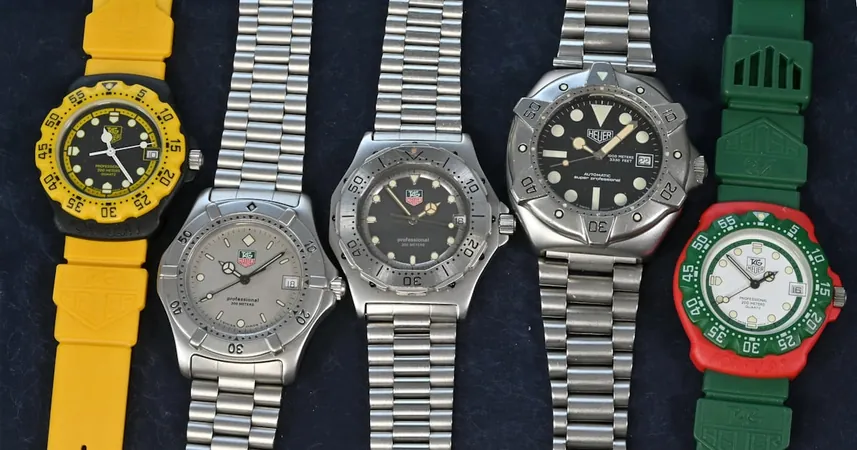
The Fascinating Backstory of TAG Heuer's Formula 1 Watches You Never Knew
2025-03-28
Author: Arjun
The TAG Heuer Formula 1 watches, bursting with vibrant colors and sporty appeal, made their grand debut in 1986. Yet, the captivating genesis of these iconic timepieces often remains obscure to many. In a revelatory conversation with veteran watch designer Eddy Burgener, we delve into the unexpected origins of the Formula 1 watch, exploring its design ethos and the innovative spirit that shaped its creation.
A Watchmaker's Roots
Eddy Burgener grew up in the heart of Swiss watchmaking — Neuchâtel and La Chaux-de-Fonds, where both his parents were entrenched in the industry. With a lineage steeped in horology, it was only natural for Burgener to pursue a career as a watch designer. After studying jewelry making at the School of Applied Arts, he learned various artistic disciplines that would later guide his visual approach to watch design. Despite the absence of formal training in watch design during his studies, his passion for innovation and aesthetics led him to craft unique timepieces.
The Evolution of Design
Burgener's career in watchmaking began in earnest with various internships, ultimately leading him to Roventa-Henex in 1980, where he designed for multiple brands, including TAG Heuer. His first project for TAG Heuer, the Heuer 2000 Series, was a turning point that embodied a progressive spirit in diving watches, incorporating functional elements tailored for divers. The success of this collection paved the way for future projects, leading to the design of the Formula 1 watch.
Crafting the Formula 1 Identity
In 1985, TAG Heuer sought to break into a burgeoning market: the young, adventurous demographics, particularly surfers and modern-day divers. The directive was clear: create a watch that was not just functional but fun and colorful — a stark contrast to traditional diving watches of the time. A significant challenge lay in using synthetic materials to yield a durable, water-resistant casing while ensuring the watch remained affordable. The birth of the Formula 1 watch was not merely an aesthetic endeavor but a feat of engineering.
Through collaboration with firms skilled in plastics and metals, Burgener and his team devised an innovative "twin combination" case. This regenerative process married a robust stainless-steel container with a colorful, synthetic exterior, allowing for greater flexibility in design and offering eye-catching colors inspired by surf culture.
The Impact of the Formula 1 Watch
Contrary to popular belief, the name "Formula 1" was not a direct homage to racing but rather a reflection of TAG Heuer’s ambition to merge their heritage in diving watches with a vibrant, youthful spirit that appealed to a broader audience. The result was a sporty, stylish timepiece that exuded an adventurous ethos — perfect for the active lifestyle of the era.
Upon its launch, the Formula 1 watch surged in popularity, quickly becoming a symbolic fusion of sport and style. Its success was not just a boon for TAG Heuer, but it also positioned the brand favorably against competitors like Casio, who were dominating the market with their colorful digital watches.
Modern Reinterpretations
Fast forward to today, and the resurgence of the Formula 1 collection, particularly with collaborations like the TAG Heuer x Kith, evokes nostalgia while appealing to contemporary tastes. Designers like Burgener continue to celebrate the watch's enduring legacy, emphasizing that even after nearly four decades, the Formula 1 watch retains its charm and relevance among new generations.
Conclusion
The story behind the TAG Heuer Formula 1 watches is more than just that of a timepiece; it's an emblem of innovation, youthful exuberance, and the relentless pursuit of excellence in watchmaking. The journey from conception to success illustrates how passion and creativity can redefine an industry. With each glance at a Formula 1 watch, wearers are not only reminded of its history but also of the spirit of adventure and boldness that still defines it today.




 Brasil (PT)
Brasil (PT)
 Canada (EN)
Canada (EN)
 Chile (ES)
Chile (ES)
 Česko (CS)
Česko (CS)
 대한민국 (KO)
대한민국 (KO)
 España (ES)
España (ES)
 France (FR)
France (FR)
 Hong Kong (EN)
Hong Kong (EN)
 Italia (IT)
Italia (IT)
 日本 (JA)
日本 (JA)
 Magyarország (HU)
Magyarország (HU)
 Norge (NO)
Norge (NO)
 Polska (PL)
Polska (PL)
 Schweiz (DE)
Schweiz (DE)
 Singapore (EN)
Singapore (EN)
 Sverige (SV)
Sverige (SV)
 Suomi (FI)
Suomi (FI)
 Türkiye (TR)
Türkiye (TR)
 الإمارات العربية المتحدة (AR)
الإمارات العربية المتحدة (AR)